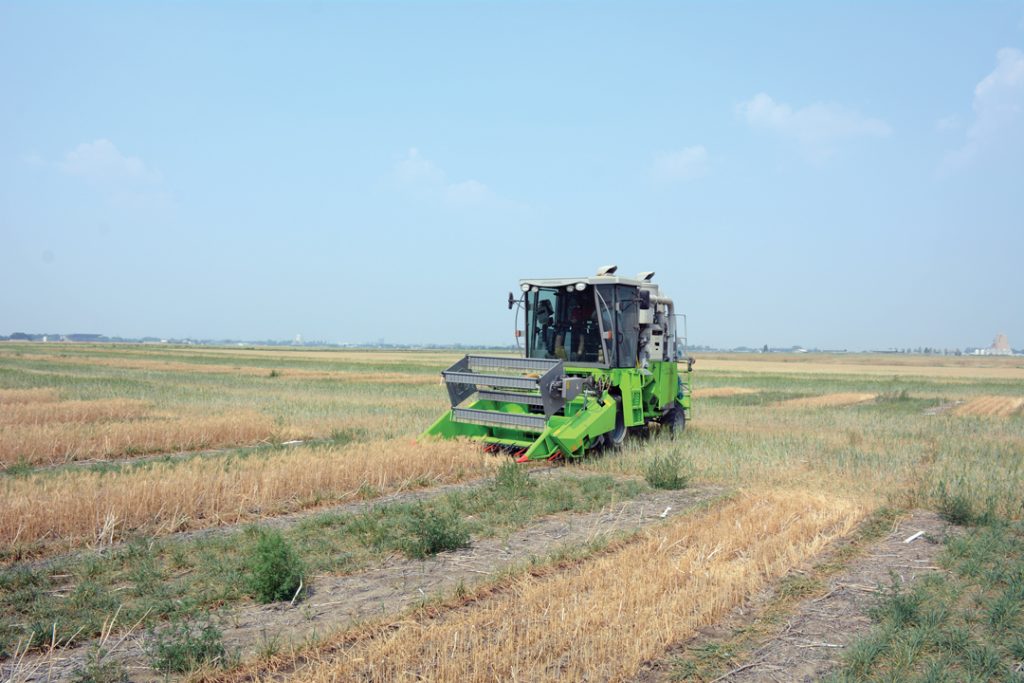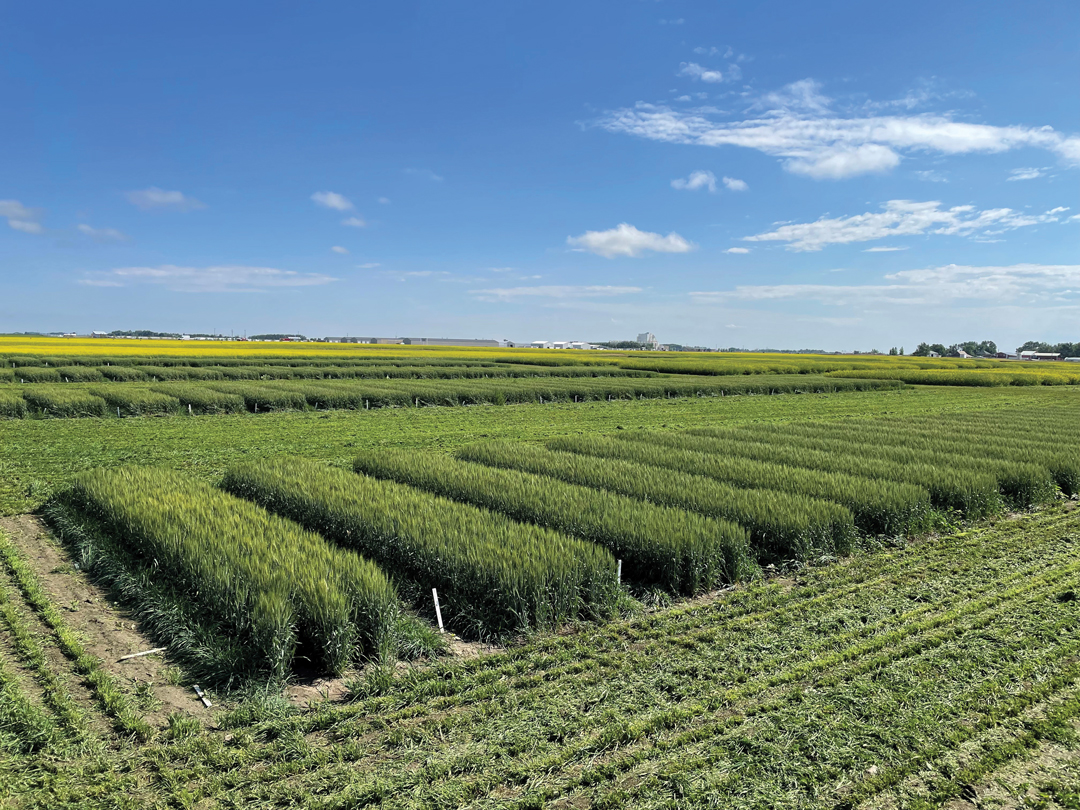4R AWARENESS AND ADOPTION
BY MELANIE EPP • PHOTOS COURTESY OF ADAM FAST
Greater adoption of the 4R Nutrient Stewardship Framework is central to the federal government’s 30 per cent fertilizer emissions reduction target for Canadian agriculture. According to the most recent 4R Nutrient Use Survey, familiarity and uptake have increased, yet barriers to improvement exist. Ongoing research indicates field practices can effectively curb nitrogen emissions. GrainsWest spoke with industry experts who all emphasized the benefits of 4R principles.
INROADS AND NEEDED IMPROVEMENTS
Based on farmer self-assessments of 4R Nutrient Stewardship adoption, the Fertilizer Use in Canada 2021 survey contains predominantly good news but also indicates room for improvement. Fertilizer Canada promotes the 4R Framework as a decision-making guide for responsible and efficient fertilizer application. The guiding principles of this voluntary initiative are increasingly well-known: choose the right source at the right rate at the right time and in the right place. The framework also aims to improve on-farm economics, crop productivity and fertilizer efficiency in a way that benefits the environment.
4R awareness has grown to 63 per cent, up 11 points among western Canadian farmers since 2015, according to Cassandra Cotton, Fertilizer Canada vice-president of policy and programs. Also impressive, 4R principles are being practiced on 9.3 million spring wheat acres or 58 per cent of the total Prairie crop. Across Canada, farmers representing an estimated 25.4 million acres said they implemented 4R principles in 2021.
According to Fertilizer Canada, 90 per cent of spring and durum wheat acres across Western Canada utilize banding, mid-row banding or seed-placed nitrogen fertilizer, a practice shown to reduce losses by up to 60 per cent. Nearly all farmers surveyed follow basic 4R right-time practices when applying nitrogen in the fall after soils have cooled or in the spring.
Wheat farmers fall short in soil sampling, though. A crucial component of the 4Rs in that it helps determine crop needs, in 2021, just 34 per cent of Prairie wheat farmers said they sampled annually. “It has stayed at that level for about the past five years,” said Cotton.
Adoption of variable rate practices also falls short. In 2021, for example, 20 per cent of Prairie farmers varied their rate by field. However, 15 per cent used advanced 4R best management practices in variable rate application. “Increasing that adoption would help ensure fertilizers are going down in the right place,” said Cotton.
4R CERTIFICATION
Farmers adopt 4R management practices for several reasons. In Western Canada the top-three drivers are to improve soil quality and nutrient availability, to use the best environmental stewardship practices and to increase economic returns. Barriers to adoption include lack of proven benefit, lack of incentive and added expense.
Farmer and Alberta Wheat Commission region 1 director Dean Hubbard is a firm believer in 4R nutrient stewardship. His farm was verified by a 4R-designated agronomist. Such certified professionals provide recommendations on nutrient management plans. Once the agronomist or Certified Crop Adviser has verified the farmer’s use of 4R principles, those acres are counted and the number submitted to Fertilizer Canada.
Hubbard would like to see more farmers utilize the verification process. “This is what we need to do to prove to the federal government we’re on the right track,” he said.
Hubbard farms 3,000 acres of wheat, canola, peas and flax near Claresholm. Since 1995, he has taken soil samples every year but one. “What I’ve found valuable is watching growth in our organic matter and how it’s affecting pH and the stability of nutrients. As our organic matter builds, we’re finding we have a better pool of nitrogen and phosphorus.”
Until recently, Hubbard utilized variable rate as well, but has backed off the practice. “Since about 2017 it has been so dry here,” he said. “For the cost of the extra analysis it was hard to see the benefit. Hopefully we get some rainfall returning. I would certainly go back to variable rate.”
According to Cotton, such flexibility is the plan’s linchpin. “That’s the beauty of the program and why we really push for the 4Rs as a holistic framework. If we promote one singular practice over another it restricts farmers’ options. That’s not something we want to do.” Farmers can choose from a multitude of sustainable practices to deliver return on their fertilizer dollars, she added.

RESEARCH AND POLICY
Agriculture and Agri-Food Canada senior research scientist Brian Beres has conducted several studies to evaluate the efficacy of the 4Rs in wheat and canola. A current study examines the integration of nitrogen fertilizer technologies with superior genetics (AC Stettler and AAC Viewfield) to optimize protein in CWRS wheat without comprising yield, environmental health or the 4R principles. The goal is to determine the benefit of enhanced efficiency fertilizers [EEF] in CWRS wheat production and to calculate potential emissions reductions benefits, if any.
Preliminary results of the five-year study, which wraps up later this year, were published in an interim report in 2022. The report indicated rate, form, placement and timing all impacted grain yield and protein at most of seven study locations. The plots represent the multiple growing environments in Alberta and Saskatchewan. In general, nitrogen applied with a nitrification inhibitor produced higher grain yield and protein in most growing environments and reduced nitrous oxide emissions by between 33 and 56 per cent. The results suggest nitrification inhibitors may improve nutrient uptake in wheat.
Intriguingly, AC Stettler showed higher grain protein and lower yield in comparison to AAC Viewfield, while the response of these cultivars differed with application and nitrogen form. The results suggest there is potential to target nitrogen forms to optimize nitrogen management by CWRS cultivar type. The study also found both nitrogen placement and timing impacted yield and protein. However, optimum timing varied between site years.
“What’s interesting is we’re not seeing the same benefits of GHG reductions with EEF in winter wheat,” said Beres. “Either we’re not collecting the greenhouse gases at the right time to observe similar levels of emissions or there’s just something about the winter wheat lifecycle in general where you don’t get the kind of emissions one thinks you would get with a spring wheat system.”
He hopes to continue this line of study under the next Canadian National Wheat Cluster. In the coming year, Beres and his research team plan to conduct a Prairie-wide effort to replicate responses over time and space to better understand which forms of nitrogen consistently mitigate greenhouse gas fluxes and in which areas. Preliminary research suggests the lifecycle of wheat plays a role in emissions reduction in wheat production systems.
The first of its kind, the study will combine spring and winter growth habits, including an ultra-early spring wheat seeding system to determine whether crop lifecycles alter greenhouse gas production. The plan is to pair growth habit and ultra-early seeding systems with nitrogen management practices to compare responses between uncoated urea and urea protected with an EEF.
While EEFs have been shown to offer benefits, they generally perform best in high-productivity environments and they’re expensive. “Because we won’t see positive returns on a 30 to 40 per cent premium for EEFs in every year and environment, widespread adoption requires some sort of incentive. You can’t ask a farmer to absorb the full cost of GHG mitigation,” said Beres.

FUNDING AVAILABLE
Implementation of new practices, especially those that offer little return on investment can be costly. To boost uptake, funding is available through the On-Farm Climate Action Fund (OFCAF), which provides financial support to farmers to accelerate adoption and implementation of management practices that lower greenhouse gas emissions.
Cotton pointed to the Canola Council of Canada (CCC), the Manitoba Association of Watersheds and Results Driven Agriculture Research (RDAR), which have received OFCAF funds to advance these practices. The funding application process is outlined on the CCC and RDAR websites.
Developed by Fertilizer Canada, the 4R Climate-Smart Protocol, also known as the Nitrous Oxide Emission Reduction Protocol, or NERP, provides Alberta farmers with another way to benefit from greenhouse gas emissions reduction. The program creates the incentive to adopt 4R practices by issuing carbon credits for their implementation.
Cotton recognizes practices such as banding reduce emissions but require large capital investments, so the return for farmers is realized over a much longer period. In some instances, where cost outweighs the environmental benefits, farmers are offered no financial incentive. “We would like to see the grower compensated for the societal benefit they provide in reducing emissions,” said Cotton.
Beres agrees. In his research proposal to study the role of wheat growth habits in GHG emissions reduction, he estimated the adoption of an improved CWRS nitrogen management system could remove 1.32 megatonnes out of the annual estimate of 20 megatonnes of CO2 that Canadian ag produces. Using numbers cited in an Environmental Defense Fund report that estimated the social cost of carbon at more than US$50 per ton, Beres speculated a modest adoption level of 25 per cent would have a societal value of US$17 million annually, or US$34 million at a 50 per cent adoption rate.
“The society value around on-farm GHG reductions is an important consideration and underscores the benefit to society when you have on-farm adoption of GHG mitigation practices,” said Beres. “In my view, it provides the basis for a shared responsibility around the associated costs of mitigation.”







Comments